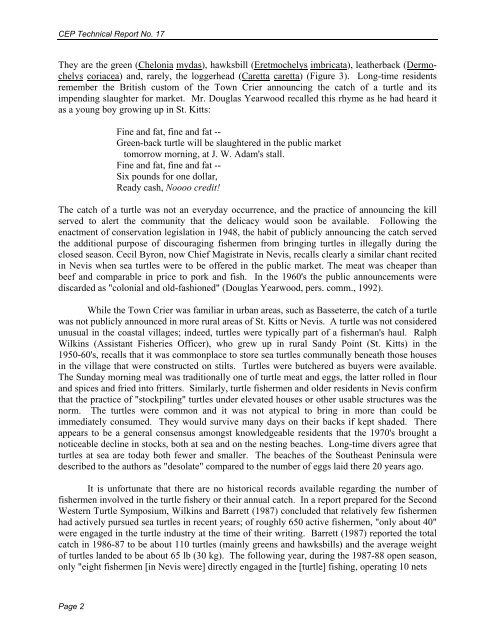Sea Turtle Recovery Action Plan for St. Kitts and Nevis - WIDECAST
Sea Turtle Recovery Action Plan for St. Kitts and Nevis - WIDECAST
Sea Turtle Recovery Action Plan for St. Kitts and Nevis - WIDECAST
You also want an ePaper? Increase the reach of your titles
YUMPU automatically turns print PDFs into web optimized ePapers that Google loves.
CEP Technical Report No. 17<br />
They are the green (Chelonia mydas), hawksbill (Eretmochelys imbricata), leatherback (Dermochelys<br />
coriacea) <strong>and</strong>, rarely, the loggerhead (Caretta caretta) (Figure 3). Long-time residents<br />
remember the British custom of the Town Crier announcing the catch of a turtle <strong>and</strong> its<br />
impending slaughter <strong>for</strong> market. Mr. Douglas Yearwood recalled this rhyme as he had heard it<br />
as a young boy growing up in <strong>St</strong>. <strong>Kitts</strong>:<br />
Fine <strong>and</strong> fat, fine <strong>and</strong> fat --<br />
Green-back turtle will be slaughtered in the public market<br />
tomorrow morning, at J. W. Adam's stall.<br />
Fine <strong>and</strong> fat, fine <strong>and</strong> fat --<br />
Six pounds <strong>for</strong> one dollar,<br />
Ready cash, Noooo credit!<br />
The catch of a turtle was not an everyday occurrence, <strong>and</strong> the practice of announcing the kill<br />
served to alert the community that the delicacy would soon be available. Following the<br />
enactment of conservation legislation in 1948, the habit of publicly announcing the catch served<br />
the additional purpose of discouraging fishermen from bringing turtles in illegally during the<br />
closed season. Cecil Byron, now Chief Magistrate in <strong>Nevis</strong>, recalls clearly a similar chant recited<br />
in <strong>Nevis</strong> when sea turtles were to be offered in the public market. The meat was cheaper than<br />
beef <strong>and</strong> comparable in price to pork <strong>and</strong> fish. In the 1960's the public announcements were<br />
discarded as "colonial <strong>and</strong> old-fashioned" (Douglas Yearwood, pers. comm., 1992).<br />
While the Town Crier was familiar in urban areas, such as Basseterre, the catch of a turtle<br />
was not publicly announced in more rural areas of <strong>St</strong>. <strong>Kitts</strong> or <strong>Nevis</strong>. A turtle was not considered<br />
unusual in the coastal villages; indeed, turtles were typically part of a fisherman's haul. Ralph<br />
Wilkins (Assistant Fisheries Officer), who grew up in rural S<strong>and</strong>y Point (<strong>St</strong>. <strong>Kitts</strong>) in the<br />
1950-60's, recalls that it was commonplace to store sea turtles communally beneath those houses<br />
in the village that were constructed on stilts. <strong>Turtle</strong>s were butchered as buyers were available.<br />
The Sunday morning meal was traditionally one of turtle meat <strong>and</strong> eggs, the latter rolled in flour<br />
<strong>and</strong> spices <strong>and</strong> fried into fritters. Similarly, turtle fishermen <strong>and</strong> older residents in <strong>Nevis</strong> confirm<br />
that the practice of "stockpiling" turtles under elevated houses or other usable structures was the<br />
norm. The turtles were common <strong>and</strong> it was not atypical to bring in more than could be<br />
immediately consumed. They would survive many days on their backs if kept shaded. There<br />
appears to be a general consensus amongst knowledgeable residents that the 1970's brought a<br />
noticeable decline in stocks, both at sea <strong>and</strong> on the nesting beaches. Long-time divers agree that<br />
turtles at sea are today both fewer <strong>and</strong> smaller. The beaches of the Southeast Peninsula were<br />
described to the authors as "desolate" compared to the number of eggs laid there 20 years ago.<br />
It is un<strong>for</strong>tunate that there are no historical records available regarding the number of<br />
fishermen involved in the turtle fishery or their annual catch. In a report prepared <strong>for</strong> the Second<br />
Western <strong>Turtle</strong> Symposium, Wilkins <strong>and</strong> Barrett (1987) concluded that relatively few fishermen<br />
had actively pursued sea turtles in recent years; of roughly 650 active fishermen, "only about 40"<br />
were engaged in the turtle industry at the time of their writing. Barrett (1987) reported the total<br />
catch in 1986-87 to be about 110 turtles (mainly greens <strong>and</strong> hawksbills) <strong>and</strong> the average weight<br />
of turtles l<strong>and</strong>ed to be about 65 lb (30 kg). The following year, during the 1987-88 open season,<br />
only "eight fishermen [in <strong>Nevis</strong> were] directly engaged in the [turtle] fishing, operating 10 nets<br />
Page 2
















